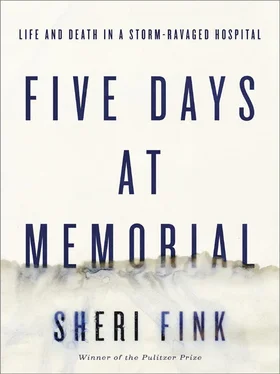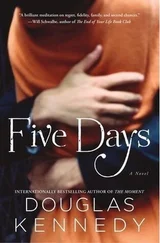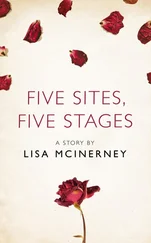A doctor told ICU nurse Cathy Green the water was coming back. “The water’s coming back?” she asked. “From the river?” No, the doctor told her, not from the Mississippi River, from the lake. “From the lake? Our lake? Lake Pontchartrain, our lake?”
The doctor told Green that water from the massive saltwater estuary north of the city had already reached Claiborne Avenue. Green attempted a calculation. The intersection was probably fifty city blocks from the lakefront.
This told her that the water wasn’t a meandering stream. It was like something she had watched on television the previous December, video footage of curious Indian Ocean beachgoers staring at a distant, muscular wave that failed to subside after breaking and instead punched across the sand, the gathering torrent of a tsunami about to flatten them.
There were certain signs, devastating signs, that told Green that an ICU patient was “crashing” toward death. This was that sign. We did not dodge a bullet, she thought. Lake Pontchartrain is emptying into our city. Very bad news is coming. It was the moment that everything changed.
Anna Pou kept calling her husband’s cell phone. There was no answer.

NEWS OF THE waters prompted an unplanned midmorning meeting in the command center. It was hot, and someone bashed out the windows with a two-foot-high metal oxygen tank. Susan Mulderick announced that up to fifteen feet was expected around the hospital. Despite Memorial’s flood-prone electrical system, its voluminous set of emergency plans did not contemplate the precise scenario they were facing, almost as if it would have been too horrible to countenance. Mulderick’s emergency committee had ranked hurricanes, floods, and power outages among the highest-priority emergencies, but the hospital’s preparedness plan for hurricanes did not anticipate flooding. The flooding plan did not anticipate the need to evacuate. The evacuation plan did not anticipate a potential loss of power or communications. Most critically, the hurricane plan relied on the assumption that the hospital’s generators would keep working for a minimum of seventy-two hours, although they were never tested to run that long. The entire 273-page set of twenty separate plans offered no guidance for dealing with a complete power failure or for how to evacuate the hospital if the streets were flooded. There was no mention of using helicopters to evacuate the hospital. There was no contract or arrangement for a company to supply them.
Surveyors from the organization that accredited Memorial, known then as the Joint Commission on Accreditation of Healthcare Organizations, or JCAHO, had fanned out across the hospital for three days in late May of that year, examining everything from the signs in the stairwells to the details in patient medical records. They identified nearly two dozen areas of required or suggested improvement, a fairly typical number.
None of the deficiencies concerned Memorial’s emergency plans. While it was possible to discern that a Memorial physician had failed to document a patient’s informed consent for treatment, or failed to write progress notes and orders for care that were legible to nurses, or had left an anesthesia cart full of controlled substances open and unsecured—all of which had been noted in the last survey—when it came to emergency management plans, it was difficult to properly assess them until they were actually needed. “There’s really no good way to test them rigorously,” Dr. Robert Wise, who introduced national standards for emergency management at JCAHO’s headquarters near Chicago, would say.
JCAHO was a nonprofit organization that Memorial, like most hospitals in the United States, hired to accredit it every third year. A “Gold Seal of Approval” from the organization paved the way for state licensure and Medicare and Medicaid reimbursement for treating patients. The Gold Seal was not a rarefied designation. Some 99 percent of hospitals achieved it, and details of their inspection deficiencies were hidden from public view. Most of JCAHO’s revenues came from fees paid by the very hospitals it accredited. In some cases, its survey teams missed serious problems at hospitals that law enforcement investigators later uncovered.
Detailed emergency management standards were a relatively recent development. In the 1990s, disaster experts from the Department of Defense and Veterans Administration warned JCAHO that hospitals needed to prepare for a growing threat of attack on American soil. The existence of a Soviet bioweapons program was disclosed in 1992. The first assault on the World Trade Center occurred the next year, followed by the 1995 Oklahoma City bombing and the Aum Shinrikyo sarin gas subway attacks in Tokyo that killed thirteen and sent thousands to hospitals. Bombings of American assets outside the country, including the US embassies in Kenya and Tanzania in August 1998 and the naval destroyer USS Cole in Yemen in October 2000, raised worries about future incidents at home.
In the 1990s, less than a page of JCAHO’s thick book of hospital accreditation standards was devoted to emergency preparedness, which was a decidedly unsexy field. Disaster managers were thought of as earnest, basement-dwelling creatures who drew up emergency plans and imposed fire drills that interrupted other people’s work. Hospital leaders kept their distance.
When JCAHO proposed new emergency standards for the new millennium, hospital executives around the country protested them, fearing a costly, unfunded mandate. “Leave us alone!” was their message to JCAHO officials. “We’re prepared.”
JCAHO’s governing board could veto proposed standards, and most of its members represented powerful industry organizations, including the American Hospital Association and the American Medical Association. Still, the board recognized the importance of better preparedness for hospital crises, and the proposed emergency standards went into effect in January 2001, nine months before the September 11, 2001, terrorist attacks.
Robert Wise, their author, had to admit that the standards were not based on much evidence. He was not convinced that they would make the hospitals that implemented them better prepared. He and his colleagues decided to wait until disasters happened, then debrief affected hospitals to figure out how much was vaporware and how much was real.
The new standards required hospitals to set up an incident command system for emergencies like the one Mulderick was currently heading for Katrina. Hospitals were also expected to coordinate plans with the wider community. Preparing for a flood in isolation did not make sense when there might be citywide power and water failures.
The 9/11 attacks and the subsequent mailings of anthrax-laced letters to politicians, media organizations, and others, which sickened nearly two dozen people and killed five of them, led to a narrowing of focus on particular types of hospital readiness. By 2005, more than a billion dollars had been made available to the nation’s roughly five thousand hospitals to promote bioterrorism preparedness. Memorial’s most detailed and by far its longest emergency planning scenario was written shortly after the 2001 attacks. This bioterrorism plan ran 101 pages, as opposed to the 11 pages devoted to hurricanes.
JCAHO had nothing to say about how realistic emergency plans had to be. Like biblical passages, the standards were written in a way that invited a generous range of interpretations. For the most part, surveyors did not check whether a hospital had the resources to do what it said it would do. Still, JCAHO’s new standards far exceeded federal requirements, meaning that hospital leaders looking to avoid meeting the new mandates could seek accreditation from one of JCAHO’s competitors.
Читать дальше













